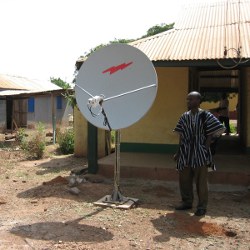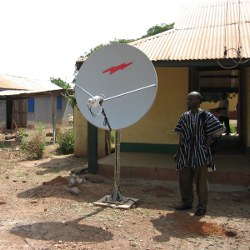
For people living and working in North America, Europe, and other relatively prosperous regions of the world, access to the Internet is a given. Even if one cannot afford a private, subscription-based fixed or mobile account, Wi-Fi hotspots offering free Internet access are relatively ubiquitous in coffee shops, public libraries, and even in certain mass transit stations, which lets everyone with a smartphone, tablet, or laptop access the Internet.
Yet in the developing regions of the world, which include but are not limited to parts of Africa, Asia, and Latin America, there is relatively sparse infrastructure in place to allow citizens of these areas to access the Internet. Moreover, even when there are connections available, many people in those regions simply cannot afford either the devices required or the account access.
“Worldwide, I think a little bit over half the world’s population does not have access to the Internet today,” says Rick Wilmer, CEO of Mountain View, CA-based cloud-managed Wi-Fi service provider Mojo Networks. “One of the major reasons why is because of affordability. In a lot of developing countries, you obviously have lower levels of income and lower levels of disposable income, and the amount of money that the general population has available to spend on something like Internet connectivity is very limited.”
Mojo Networks is one of several companies and organizations that are trying to bring connectivity to these underserved regions of the world. The company’s largest effort is a venture with Reliance Jio, a wireless telecom provider based in India that has more than 100 million subscribers. Mojo Networks is supplying Reliance Jio with Wi-Fi network access points at cost, thereby helping the wireless carrier offer Wi-Fi hotspot access to consumers for free or at very low cost.
As of January 2018, Reliance Jio has deployed more than 100,000 base stations in India, with plans to double that number this year. Currently, non-Jio customers can access the Wi-Fi network for free for up to 30 minutes without getting disconnected. If a user is a Jio customer, they can remain connected to the Wi-Fi hotspot beyond that time limit, and any data use will be billed to the customer’s data package. This package is still quite affordable in local terms, with the lowest-cost package starting at a cost of about 98 rupees (US $1.53), which provides 28 days of access and a data cap of 2GB.
Clearly, there is more than altruism at work, when considering bringing Internet connectivity to places in the world where there is little discretionary income. Indeed, companies such as Mojo Networks are seeing a benefit to making access hardware affordable and shifting its business model to offer recurring revenue-based value-added services to local ISPs.
“I can’t necessarily say that we’ve done this exclusively for solving the problem of affordability in the developing world,” Wilmer says. “We’re selling cloud services, so we really now look like a SaaS (software as a service) company. Our SaaS offering is a suite of applications that live in the cloud that allow a customer to manage their Wi-Fi network; that’s how we make our money.”
Other tech companies have also launched initiatives that are designed to provide access via hotspots. Facebook has partnered with India telecom giant Bharti Airtel to help it debut 20,000 Internet access points across the country, as part of the social networking company’s Express Wi-Fi project to sell inexpensive Internet access in regions where web coverage is limited.
However, expanding the number of hotspots alone will not be enough. The greatest challenge to providing access to rural or underdeveloped regions is a lack of Internet infrastructure, simply because there has not been a concerted effort to bring big data pipes to those regions. Known as Internet backhaul services, these networks connect local access providers to the Internet itself, and usually are built using expensive solutions, such as undersea broadband cables or a network of satellites, in order to handle the huge traffic demands placed on the network. Without a guaranteed network of revenue-generating users, there is no incentive for a telecom company to lay out the capital required to lay cable or launch satellites.
One company that tried to address this issue is MainOne, a provider of telecom services and network solutions for businesses in West Africa, which started with the goal of building an undersea broadband cable stretching 4,350 miles from Portugal to Nigeria, with stops in Ghana. The company began in 2008 by raising money from Nigerian investors, and two years later, was selling access to local Internet service providers (ISPs).
It appears efforts such as these are working. According to a 2018 report from advertising and marketing agency We Are Social and social media management firm Hootsuite, Internet users in Africa are up by more than 20%; the number of people accessing the Internet in Mali, for example, has increased by nearly six times in the past year. Similarly, the number of Internet users in Benin, Sierra Leone, Niger, and Mozambique have more than doubled over the same time frame.
Undersea cables are helpful, but bringing Internet access to landlocked countries or regions requires connections to be brought into these regions, and then supported by local ISPs. Companies such Liquid Telecom, EveryLayer, and others are working with independent ISPs in cities and villages by helping to negotiate rates for these backhaul services so that they can provide affordable access to consumers.
Wilmer says providing backhaul services to these remote areas is a key challenge. “That’s another problem that needs to be overcome.”
Google has launched a project to use light beams to bring rural areas of the planet online, after it announced a planned rollout in India. Alphabet’s X, the new name for the company formerly known as Google X, is working with telecom operator AP State FiberNet in India to utilize Free Space Optical Communications (FSOC), a technology that uses beams of light to deliver high-speed, high-capacity connectivity over long distances. The project will use 2,000 FSOC links to add capacity to its network, which requires connecting 2,000 boxes installed as much as 12 miles apart to create a new backbone to supply service to cellphone towers and Wi-Fi hotspots. Alphabet X’s work in India is part of a government initiative to connect 12 million households to the Internet by 2019.
Google also has been trialing an initiative called Project Loon, which involves maintaining a fleet of balloons to provide Internet coverage to users on the ground in remote regions. The system was designed to provide high-speed Internet connectivity by transmitting signals from the ground to a network of balloons in the sky, routing the signal to adjacent balloons on the network and then back down again to users on the ground. However, “the balloons don’t seem to have worked out very well,” according to Darrell West, vice president of governance studies at the Brookings Institution. “Apparently, there have been problems with maintaining them at a steady height, because local airflows are pushing them up or down and disrupting communications.”
West says the use of satellites to bring Internet coverage to wide geographic areas is a more reliable solution. Companies such as OneWeb, which is backed by Virgin founder Richard Branson, and SpaceX, Elon Musk’s venture, are placing satellites in low Earth orbit (100 to 1,250 miles overhead) to provide fast Internet access with low latency rates. Because these lower-latency satellites are not positioned as high in the sky as traditional satellites, more are required to provide adequate coverage of a region, West says.
Quika is one company actively working to bring a free satellite Internet broadband service to underserved geographic regions. Scheduled to launch in the second quarter of this year, the Quika service promised speedy, low-latency Ka-band data connectivity in developing countries, where income inequality and a lack of infrastructure (especially in rural areas) make conventional Internet access impractical for most. Service was slated to begin in Afghanistan and Iraq, and as those services gain traction, additional countries will be supported via local agents in a variety of countries, according to Quika chairman Alan Afrasiab.
“We are aiming to provide citizens of developing countries and those in rural areas trapped by poor and/or expensive Internet infrastructure with a decent, quality connection to help bring about real change to empower communities,” Afrasiab says. “Quika Free will target those on low incomes,” and services will be available across a range of offerings, from advertising-supported free services, to volume-based services available on gigabyte-per-month plans. Afrasiab says Quika also will target larger commercial organizations. “Quika Plus, VNO, and Trunk will be offered to those who require significant amounts of data or dedicated access to our MPLS network.”
It is not just technical or cost issues that can make providing Internet access difficult. Internet access providers face their own regulatory issues, including the possibility of being required to censor content for local governments. That’s why most low-cost Internet services are fairly basic in terms of content, West says. “You get access to job listings, to weather, to news, and entertainment sites,” he says, adding that some providers are also offering messaging capabilities.
Overall, the goal of these Internet providers is to give people who have never used the Internet a taste of the features and benefits of Internet access, so that it becomes a “must-have” in their lives, rather than a “nice-to-have.”
“The key barrier is the initial deployment,” West says. “Once people start using the Internet, they generally want to use it more, and so it becomes a higher financial priority for them. So, once [access is provided], then the market is in a stronger position to take over from there.”
Mumbere, D.
Digital in 2018: Africa’s Internet Users Increase by 20% Africa News.com, Feb. 6, 2016, http://www.africanews.com/2018/02/06/digital-in-2018-africa-s-internet-users-increase-by-20-percent//
Kemp, S.
Digital in 2018: World’s Internet Users Pass The 4 Billion Mark https://wearesocial.com/blog/2018/01/global-digital-report-2018
Sokol, E.
Internet access in the developing world March 15, 2017, https://www.youtube.com/watch?v=qN1lZgiHi9o





Join the Discussion (0)
Become a Member or Sign In to Post a Comment